Have you ever stepped into a woodland and felt an instant sense of calm, as if the noise of the world had faded away? Photography mindfulness allows you to channel that serenity into your creative process. More than just a way to take photos, it’s a practice of being fully present in the moment, connecting with the landscapes you capture and with yourself.
When applied to nature, mindful photography techniques invite you to see beyond the obvious and notice hidden details – a shaft of sunlight through the trees, the texture of moss on a fallen log, or the ripples in a quiet stream. These small moments, often overlooked, are where creativity thrives. By practising mindful nature photography, you can transform your craft into a deeply creative and meditative experience, unlocking fresh perspectives and meaningful images.
In this article, you’ll discover practical steps, tools, and insights to bring photography mindfulness into your outdoor shoots. Whether you’re wandering through a forest or capturing a sweeping landscape, mindfulness can awaken your creativity and deepen your connection to your photography.
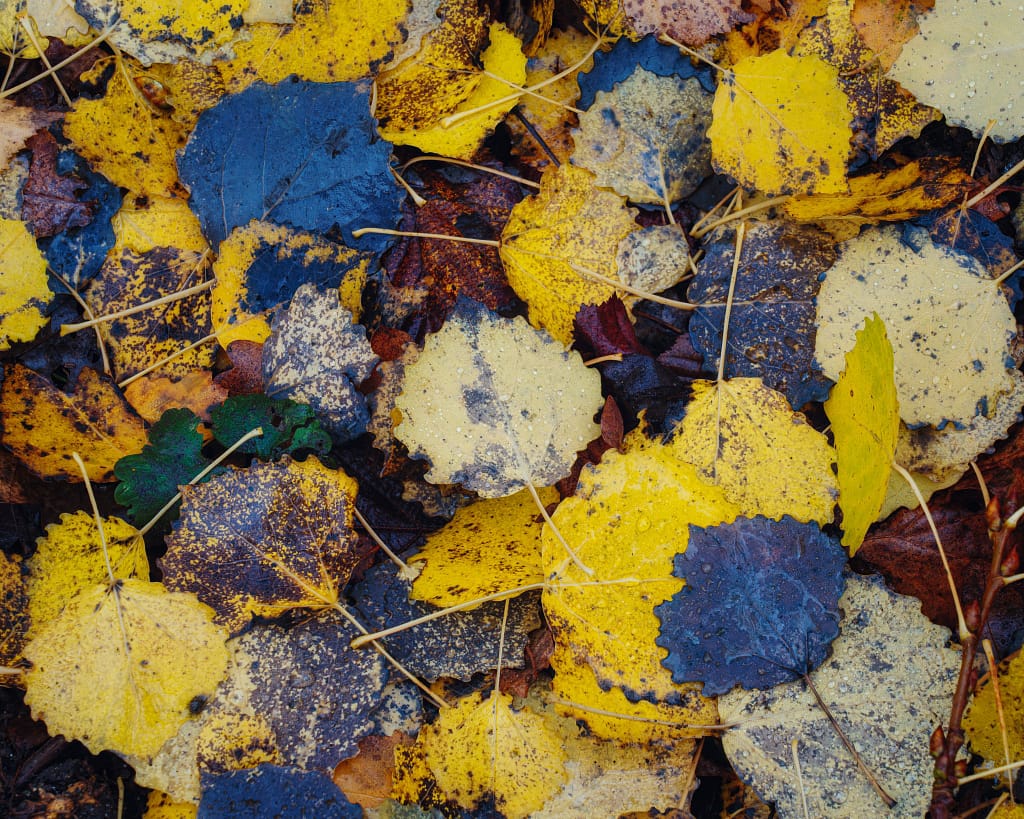
A close-up of a forest floor covered in a mixture of fallen leaves. The leaves are predominantly blue and yellow, with some displaying a blend of both colours. Thin stems are scattered among the leaves.
What you’ll learn:
- How photography mindfulness nurtures creativity in nature.
- Practical mindful photography techniques for your next photo walk.
- Tools to enhance your focus in mindful nature photography.
- Strategies to overcome distractions and perfectionism.
Why Photography Mindfulness Unlocks Creativity
Photography mindfulness teaches us to slow down and pay attention to the world around us. It’s about noticing what’s happening in the present – the rustle of leaves in the breeze, the subtle play of light and shadow, or the earthy scent of moss after rain. In nature, this practice becomes even more profound, sharpening your senses and helping you see creative opportunities you might otherwise overlook.
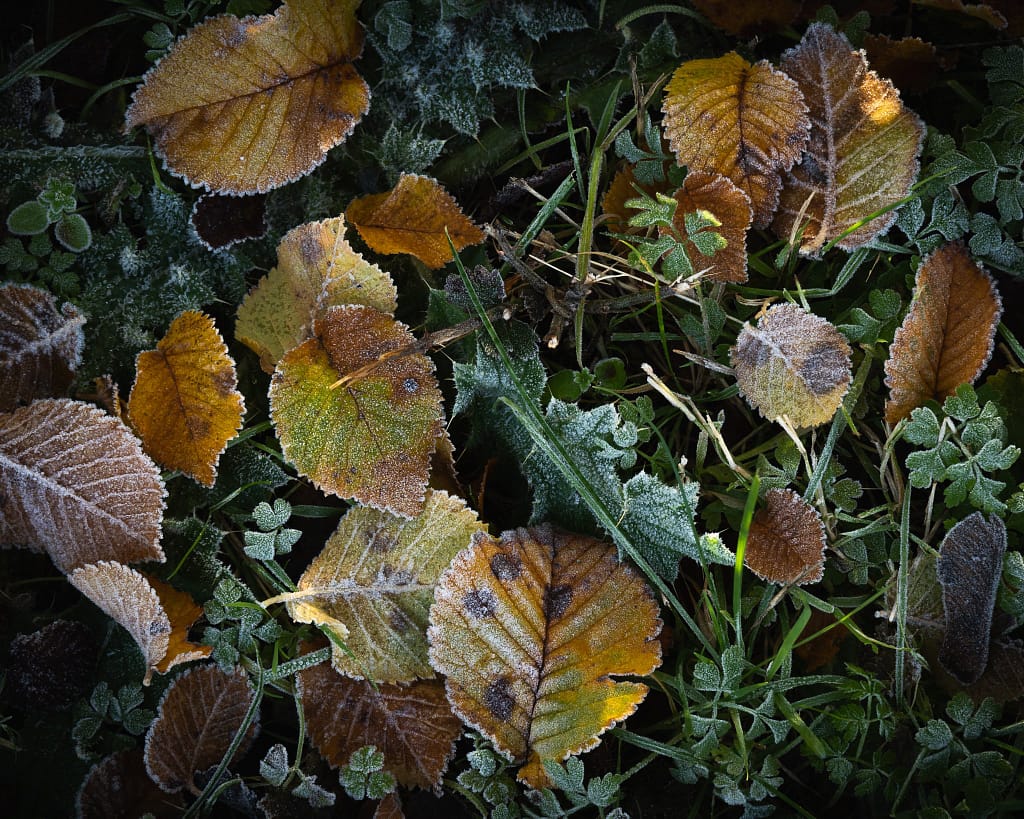
Frost-covered autumn leaves in varying shades of brown, orange, and green are strewn across the ground. The texture of the leaves and glistening frost creates a visually rich, natural scene.
One frosty morning in a local woodland, I came across a patch of ice-covered leaves. At first, it seemed unremarkable. But as I knelt down and allowed myself to truly observe, I noticed how the ice had formed intricate crystalline patterns, refracting light in unexpected ways. That quiet moment, filled with curiosity and presence, turned into a study of texture and light. By embracing mindful nature photography, I captured a series of images that celebrated the fleeting beauty of winter.
This is the essence of mindfulness in nature photography: allowing your surroundings to guide you without the pressure to find the “perfect shot.” By immersing yourself in the process, you open the door to creative breakthroughs, seeing familiar scenes with fresh eyes.
How to Use Mindful Photography Techniques to Spark Creativity
Plan a Mindful Photo Walk
A mindful photo walk is an intentional practice that helps you tune into your environment. Choose a location that inspires you – a dense woodland, an open meadow, or the edge of a quiet stream. Walk slowly and deliberately, allowing your senses to guide you. Notice the interplay of light and shadow, the texture of tree bark, or the subtle colours of a forest floor.
Resist the urge to jump straight into capturing images. Instead, spend time observing and immersing yourself in the atmosphere. Pause often, letting yourself connect with the scene before raising your camera. This approach not only calms your mind but also helps you uncover creative opportunities you might otherwise miss.
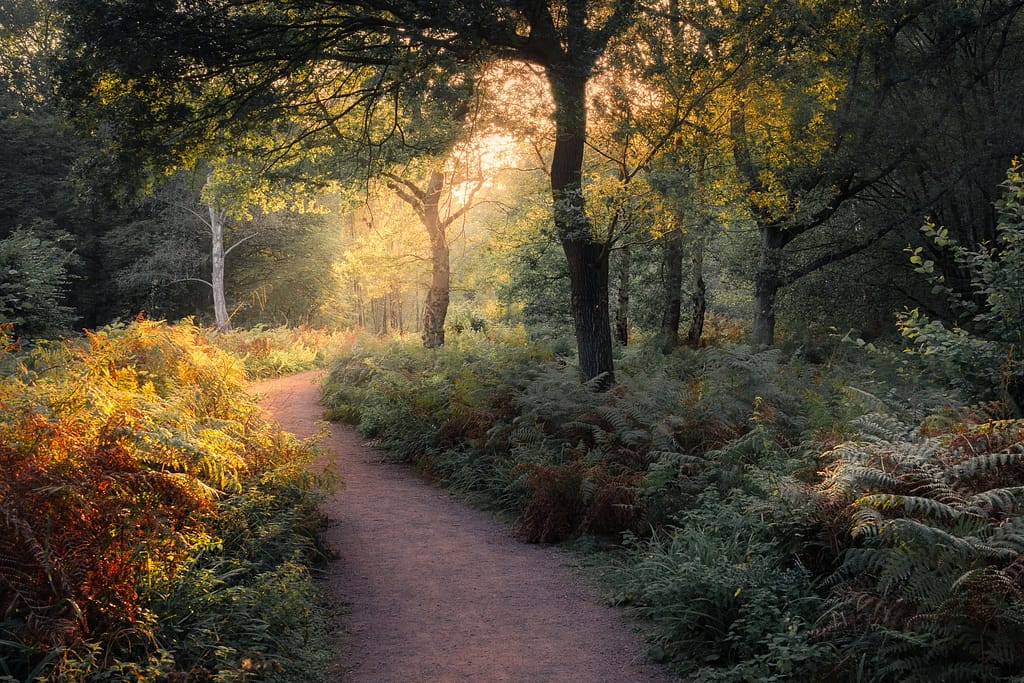
A serene forest scene with a sunlit dirt path meandering through dense greenery.
Focus on One Element
Nature is abundant with inspiration, which can sometimes feel overwhelming. One way to practise photography mindfulness is by focusing on a single element during your shoot. This could be light, texture, patterns, or even a specific colour. By narrowing your focus, you train yourself to see deeper and more creatively.
On one of my own photo walks, I decided to focus solely on light. As I moved through the forest, I noticed how morning sunlight created golden edges on the leaves, casting intricate shadows on the forest floor. By limiting my attention, I wasn’t just documenting a scene – I was engaging with it fully, allowing light to guide my creative choices.
Practise Gratitude and Playfulness
Gratitude is a powerful aspect of photography mindfulness. Before you start shooting, take a moment to appreciate the privilege of being surrounded by nature. Whether it’s the stillness of a woodland or the grandeur of a mountain range, reflecting on your environment fosters a deeper connection to it.
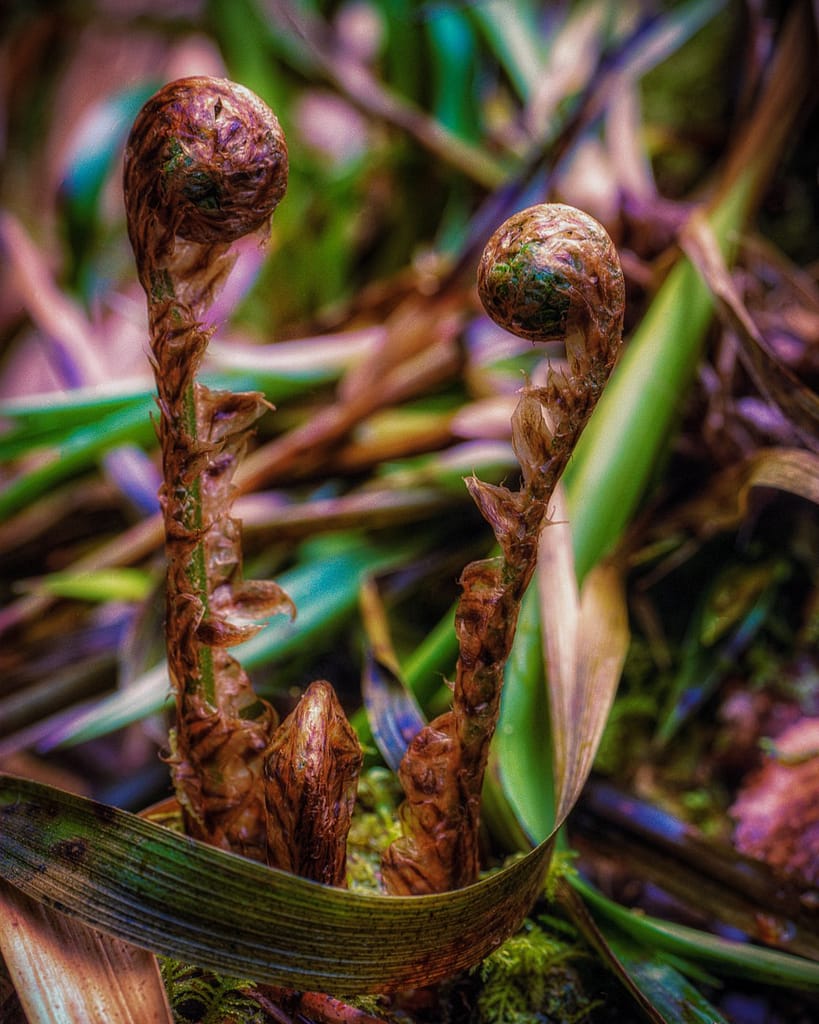
Close-up of two spiralled fern fronds emerging from the forest floor, surrounded by green leaves and moss.
Playfulness is equally important. Experiment with unconventional compositions, angles, or even camera settings. Tilt your camera to find unique perspectives or use a lens you rarely rely on. By approaching your craft with curiosity and a willingness to explore, you allow creativity to flourish. Sometimes, the unexpected results are the most inspiring.
Tools to Support Mindful Nature Photography
Lightweight Gear for Simplicity
When photographing in nature, simplicity is key. Carrying too much gear can distract from the mindful experience and weigh you down. Opt for a lightweight setup: a single camera body, one or two versatile lenses, and a compact tripod for slower, deliberate shots.
A macro lens is particularly useful for mindful nature photography, allowing you to capture the intricate details of moss, fungi, or frost-covered leaves. Keeping your gear minimal not only lightens your load but also helps you focus on the scene in front of you.
Apps for Mindfulness and Photography
Certain apps can complement your practice of photography mindfulness. Apps like PhotoPills or The Photographer’s Ephemeris are excellent for planning shoots around natural light, weather, and location. Meanwhile, mindfulness apps like Calm or Headspace can help you centre your focus before stepping into the field.
These tools are not about distraction – they’re about enhancing your connection to the environment and helping you make the most of your time in nature.
Journaling for Reflection
Reflection is an integral part of mindful photography techniques. After each shoot, take a few moments to journal about your experience. What inspired you? What did you notice that you hadn’t before? Did you feel a sense of connection to the environment?
???? FREE TEMPLATE: Mindful Photography Prompts For Planning & Reflection ????
These reflections not only deepen your mindfulness practice but also serve as a source of inspiration for future shoots. A photography journal becomes a record of your creative growth, helping you recognise patterns and new ideas over time.
Overcoming Challenges in Mindful Nature Photography
Managing Distractions
Even in the tranquillity of nature, distractions can arise – whether it’s external noise or your own wandering thoughts. When this happens, mindfulness exercises can help you refocus. Try deep breathing or pause to listen to the sounds around you, such as birdsong or the wind rustling through the trees. These small moments of grounding keep you present and engaged.
Letting Go of Perfectionism
Nature is inherently unpredictable, and so is photography. The pursuit of perfection often leads to frustration and missed opportunities. Photography mindfulness teaches us to embrace imperfections – the crooked branch, the uneven light, the unexpected.
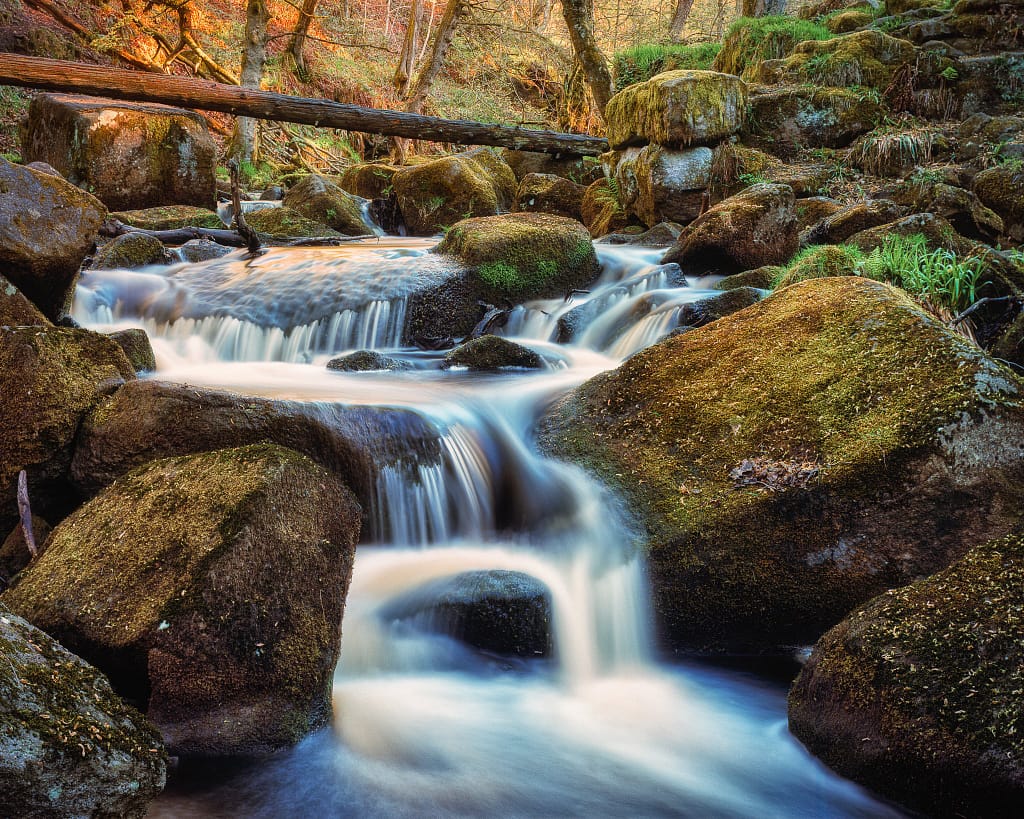
A tranquil woodland scene with a cascading stream flowing over moss-covered rocks. A fallen log forms a bridge across the stream above.
I once spent hours trying to photograph a woodland stream in perfect symmetry, only to realise that the untamed shapes of the surrounding rocks told a more compelling story. By letting go of rigid expectations, I discovered a scene far more dynamic and alive than anything I had planned. Creativity thrives when you allow yourself to work with nature’s imperfections rather than against them.
Conclusion
Photography mindfulness is more than a technique; it’s a way of experiencing and connecting with the natural world. By slowing down, embracing presence, and letting creativity flow, you’ll not only capture more meaningful images but also rediscover the joy of photography.
Through mindful photo walks, reflective journaling, and playful experimentation, you can unlock a wellspring of creativity in your woodland and landscape photography. Tools like minimalist gear and mindfulness apps can further support your practice, helping you stay grounded and focused on your outdoor shoots.
Next time you venture into the forest, let go of expectations and allow mindfulness to guide you. In the stillness of a woodland or the shifting light of a meadow, creativity is waiting for you to discover it.

